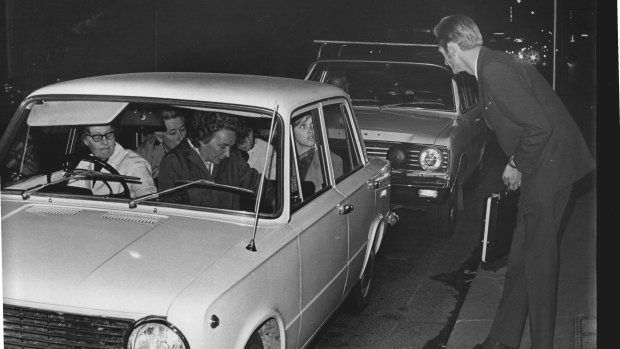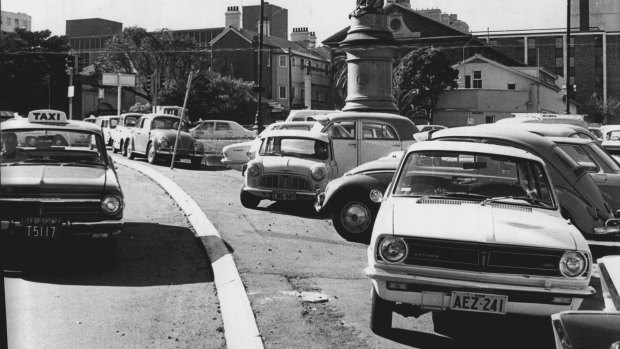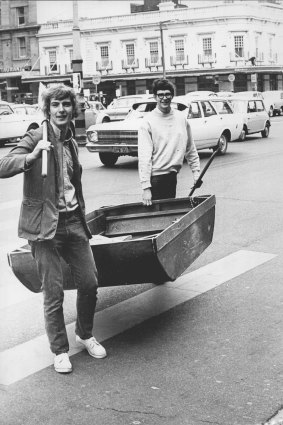By Staff reporters
First published in the Sydney Morning Herald on May 21-22, 1969
About 700,000 people in N.S.W. will be without their regular transport today because of the State's first combined strike of Government rail, bus and ferry employees.
It will be the worst transport strike in the State's history.

A lucky hitchhiker scores a lift in an already crowded car on Clarence Street, Sydney. May 21, 1969.Credit: Merv Bishop
Nearly 600,000 of those directed would normally travel to and from work in peak hours in Sydney.
Ferry men have joined a general transport strike for the first time. Previously the ferries carried a considerable number of extra passengers who could not get to work by bus.
(The last Government transport strike, on August 14, 1967, stopped rail and bus services but not ferries.)
The major services normally carry most of the 28,000 people who use the ferries every day.
(Published May 21, 1969)

Parked cars crammed into Victoria Square, May 21, 1969. Credit: Frank Burke
Hundreds walk to work over Bridge
Hundreds of people walked to and from work across the Harbour Bridge yesterday during the general transport strike—and police worked 14 hours and more to keep a steady flow of traffic in and out of the city.
At 9.30 a.m., crawling traffic was banked up along the whole length of the Bridge.
It took many motorists and their passengers more than l ½ hours to cover a trip that would normally take them 30 minutes.
In general, traffic in the city during the day moved fairly well, the main congestion occurring at bridges.
One of the worst evening traffic jams occurred on the northern approach to the Harbour Bridge after 4 p.m., when up to six lanes of traffic were forced to merge to use the only two south-bound lanes available—on the Cahill Expressway.
At this stage, while hundreds of south-bound cars were banked up in Mount Street and on the Cahill Expressway, only light traffic was travelling north on the main lanes of the Bridge.
With darkness falling in the city, pedestrians were getting desperate.
Mr Peter Donovan, who was standing in Macquarie Street, with a large sign reading "Hornsby," said: "I've been standing here for half an hour and nobody has offered me a lift."
"It looks like we'll be walking," said John Dash, as he stood with his wife, Jenny, in Grosvenor Street. "We have a sign but nobody seems to want to stop."
The Dashs, who live at Wollstonecraft, said they had driven to North Sydney yesterday morning and walked across the Bridge - taking 1½ hours. Mr F. Forbes, of Collaroy, was waiting in Grosvenor Street for his brother-in-law who was coming from Redfern to give him a lift.
"It usually takes me 40 minutes to get to work, but this morning I left home at 7.15 and didn't get to work until 9.50," Mr Forbes said.
"Mr Morris' appeal didn't do much good — at Narrabeen this morning, while I was waiting for my brother-in-law, 186 cars with only the driver in them went past in 10 minutes, and only three asked if I wanted a lift."
One of the fastest moving things in Grosvenor Street was a bespectacled young man in a scarlet singlet, running shorts and sandshoes, who was loping down York Street towards the Bridge and outstripping all but a few motor-cycles which were weaving in and out of the stationary traffic.
Thousands of people were standing in York Street, Queen's Square, William Street and George Street trying to get lifts.
Unions involved
The unions who took part in yesterday's 24-hour general stoppage were: The Australian Railways Union, the Australian Federated Union of Locomotive Enginemen, the Tramways and Motor Omnibus Employees' Association, the Waterside Workers' Federation, the Firemen and Deckhands' Union, the Seamen's Union of Australia and the Painters' and Dockers' Union.
Staff shortage at the G.P.O. delayed telegrams for many hours during the strike.
(Published May 22, 1969)
Trade in city stores down heavily

Photographer Fred Murray found Brian Griffiths (left) and Peter Williamson carrying their six-foot dinghy at Circular Quay. They'd rowed across harbour from Mosman, landed at Mrs. Macquarie's chair, and were carrying the boat up town. Then workmen at Circular Quay volunteered to mind the dinghy until the boys row home tonight. May 21, 1969.Credit: Fred Murray
Sydney shops reported yesterday that the transport strike had reduced their trade by up to 75 per cent.
Before lunch, department stores appeared largely devoid of customers.
At 11.15 a.m., a "Herald" reporter counted 17 customers on the whole of the ground floor of Woolworth's Pitt and Market Street store.
In Coles', at the corner of King and George Streets, a magician who usually attracts a large crowd performed card tricks before an audience of one.
Owners of some smaller arcade shops said they had been visited by only two or three customers all morning.
By 3 p.m. the main stores were almost empty, and staff with long walks ahead of them were being allowed to go home.
"It's been pretty dead all day," a supervisor at Farmer's said, "but at least it gives us a chance to catch up on some paper work.
"Only about half the staff on the first floor managed to get here at all, so there was a bit of a rush when our blanket sale opened first thing.
"But since then — it's been a nice easy day — a few more strikes would be great, except that I've got a great trek home facing me."
Visitors to the World Trade Fair, many from overseas, kept David Jones' slightly more busy.
On the windy Town Hall corner at 5 p.m., where thousands are usually rushing to catch buses and trains, the relatively few on the streets were walking along at a leisurely pace.
Below in the subway life was almost at a standstill. Nearly all the kiosks were closed and the thundering of trains was conspicuously absent.
(Published May 22, 1969)